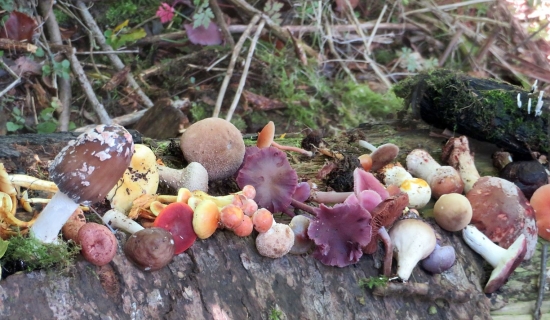Reports
A visit to The Deep
20 June 2024
On a cold Saturday morning in June, 20 RSB members and their guests arrived at the internationally renowned aquarium ‘The Deep’ sited on the banks of the grey Humber estuary in Hull. The welcome inside was however warm and inclusive. We wandered the extensive and educational galleries which were so much more than aquarium tanks but explanation from the ‘origins of life’ on earth to ‘where are the best places to collect fossils on the Yorkshire coast‘ The exhibits in the aquaria were stunning, from living species in mangrove swamps to tunnels where we could get face to face with sharks!
The penguin enclosure was ever popular with the audience particularly as they are part of a well-publicised breeding programme. Most exhibits were well explained by informative narratives describing the concepts involved. ‘The Deep’ is able to engage adults as well as children in biological education at an appropriate level.
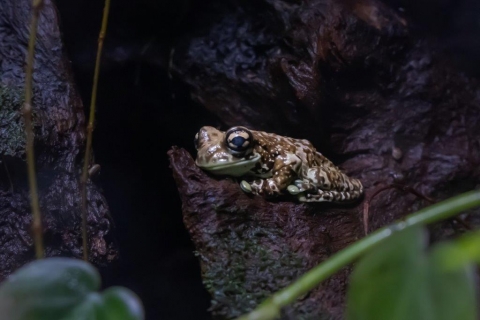
An Amazon Milk Frog
The highlight for most of our party was the specially arranged ‘behind the scenes’ tour where our enthusiastic aquarist guide explained how they pamper all the aquatic exhibits – sourcing only sustainable specialised food appropriate to their country of origin as part of their attempts to manage the collection with conservation of species in mind and sustainability of their work where possible. Many exhibits, including their two Loggerhead turtles, are ‘rescue’ animals from the wild; others are part of long term conservation projects such as that involving various jellyfish species. A visit to ‘The Deep’ in Hull is recommended to learn more about the variety of excellent conservation projects at this internationally renowned venue.
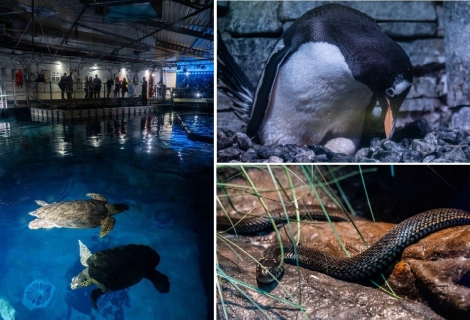
The group enjoying the behind the scenes tour, a Gentoo Penguin with its egg, and a Lake Zacapa Garter Snake
Dr Ron Dixon FRSB - Chair East Midlands Branch
Fungal Foray
29 October 2023
Increasing recognition of the significant roles in nature played by fungi connecting with trees to either enhance or inhibit growth, makes the imaginative Tolkein’s creation of trees as communicating beings closer to a reality. Some thirty members and guests of the East Midlands Branch of the Royal Society of Biology enjoyed a sunny morning fungi-hunting in Twyford Woods, also known as the old Canadian Air base and seen in Dr Who.
This is part of a long-term study where we have seen up to 92 species in a morning in past years, but fewer more recently. Weather prior to our visit had been reasonably warm and wet so our finds were as good as they could be. Over the years, we have added to new species to the list. There are now 148 species on the site list in total and under good conditions, on this morning, we found 87 species, many of them new additions to the list. (74 from Ray Halstead and further specimens confirmed by Jane Ostler on video and David Feld) The full list is available.
We had a good turnout - of thirty people in two groups, with and without children – all coming along to discover the exciting world of fungi amongst the Autumn colours of Twyford Woods. The Wood has a good range of different habitats, with both pine and deciduous woods, wet grassland and open areas.
We also had with us lichenologist Geoff Buck MRSB, who checked out some of the common lichens and mosses. “I must admit I love walking around woods, fields, along the river banks…. Anywhere wet and muddy,” he said, spoken like a true field biologist!
Cladonia fimbriata and Hypogymnia physodes were included as well as the inevitable Xanthoria parietina and Physcia adsendens. He also added the moss, Polytrichum commune to the list. Also of interest, was the free-living alga, Trentepohlia, which is also a lichen symbiont.
Thanks to mycologist County Recorder, Ray Halstead, for leading the survey and to local expert Jane Ostler who started the regular survey many years ago and examined our specimen collection at home. Thanks also to microbiologist Dave Feld FLS, CBiol, MRSB, MIScT for his expertise and support. Thanks also to the RSPB explorers and Wildlife Watchers whose keen young eyes assisted with many finds.
Marianne Overton MBE FRSB and Geoff Buck MRSB
AGM and Charter Lecture ‘100 Years of Insulin’
7 November 2022
The University of Leicester provided an ideal venue for our first live AGM and Charter Lecture since the pandemic. Around 45 people including members, non-members and some keen sixth formers attended in person, with a further 18 joining online.
Professor Melanie Davies CBE, took us on an amazing journey through the decades, reminding everyone of the incredible technological changes in our lives and linking those to what was happening in the way Type 1 diabetes (T1D) was being treated and managed. Speaking from an experienced clinician’s perspective, she began by reminding us all that in the early 1900s a diagnosis of diabetes, particularly in childhood, was tantamount to receiving a death sentence. Spending long spells in hospital, they would be on a starvation diet in an attempt to assuage the ravages of the disease. The essential role of the pancreas was already known, but in 1910 Sir E. A. Sharpey-Shafer suggested that one very important chemical was missing in a person with diabetes. He called it insulin from the Latin insula meaning ‘island’.
Switching to London, Ontario in October 1920, Professor Davies outlined the famous insulin story involving the work of Dr Frederick Banting and his associate Charles Best. Banting’s idea to ligate the pancreatic ducts of dogs enabled the isolation of an active extract from the Islet cells. A more purified extract was eventually produced enabling the survival of a 14 year old boy, Leonard Thompson, the first person to receive an injection of insulin. The move from miracle to large scale production quickly followed and swept across the world.
In the 1930s new formulations increased the purity of the product and tolerance to it. However, the burden on the daily lives of patients was still high. Injections were painful, insulin stability was poor and there was much variability. Patients often suffered debilitating hypoglycaemic incidents.
Purification methods continued to improve the insulin derived from cattle and pigs and by the 1950s production had nearly tripled to meet demand. In particular, second generation insulins that were complexes with metals or proteins produced a longer lasting product. People with T1D were now living longer and in the 1960s there began the management of complications that can develop with diabetes, such as retinal disease.
As the 70s-80s dawned and we began sending emails and using mobile phones, semi-synthetic insulin and that derived from recombinant DNA came to the fore and the first insulin pumps were used. The burden on patients was beginning to ease and there was less risk of hypoglycaemia. The pace of change continued to quicken in all areas and the first insulin pens appeared in the 1990s. So much easier to handle and they could be used more discreetly.
Bringing things up to date, Professor Davies described some of the more recent advances in technology such as sensor augmented insulin pumps and flash monitoring of glucose levels which help patients to achieve very satisfactory, near normal, ambulatory glucose profiles. As one lady in the audience explained after 41 years as a diabetic - a truly remarkable transformation.
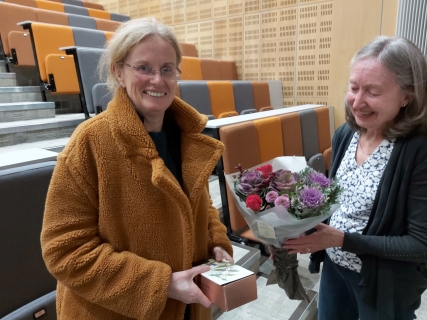
However, and in spite of the many advances in the past 100 years, we were left pondering the challenges that remain, particularly on a global scale.
Rosemary Hall MRSB
Knepp Estate Conservation and Rewilding Safari
14 August 2022
It is a swelteringly hot, summer Sunday in Surrey, with a blue sky so intense it hurts to look at it. Here, twelve lucky people are gathering to meet for the first time and to wander the majestic rewilding paradise of Knepp Estate. The area has been owned by the Burrell family for over 220 years, most of which, until recently, was devoted to traditional arable and dairy farming. But in 2001, based on a continuous trend of losing money, it shifted its focus from intensive farming to conservation. A minimal intervention and restoration effort driven by the guiding practice of rewilding.
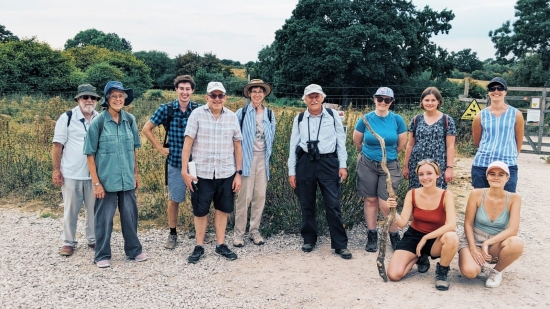
It is now 14:00 and our tour guide Paul is ready to lead us out to see for ourselves what this hidden ecological project has managed to achieve. Download the full report to read more.
Emilio Aldorino MRSB
Regional Schools Essay Competition to celebrate British Science Week 2022
16 March 2022
The prize for winning first place in the East Midlands branch Biology Essay Competition was a full day experience in the laboratories of the Aquatic Research Facility at the University of Derby. I was under the care of Dr Michael Sweet, a well-established and fascinating coral biologist who could tell me all about his exciting travels and research conducted around the world.
The day was split into four parts beginning in the aquatic laboratories which are well stocked with top of the range 400 litre tanks, complete with complex filtration systems, specialised lighting, temperature control and, most importantly, an array of beautiful coral, with fish to keep the ecosystem stable. I was shown around the facilities and was even able to feed the coral and see their tentacles grabbing onto food particles! After this, I was taught how to use both the light and SEM microscope, the latter of which I had never even seen in action before. I took my own images, and even helped a PhD student categorise and study baby corals up close. I then had lunch with Dr Sweet, where we talked about his research in more detail and where I would like to take my studies in the future.
The afternoon was spent with third year students, who guided me through some practical bacteriology and allowed me to use the centrifuge to separate some urchin gametes! Everybody I met at the university was welcoming and very willing to give up their time to teach me new skills and say more about their work. I greatly appreciated seeing what academics do in their day to day lives. My time at the university was brilliant, and I couldn't have wished for a better prize.
Miss Esther Eastwood, BioNet member
AGM and Origin of Life Lecture
4 November 2021
The East Midlands branch invited Professor Nick Lane FRSB, an evolutionary biochemist and writer in the Department of Genetics Evolution and Environment at University College London, to enliven their AGM with a lecture on his fascinating work on the biochemical beginnings of life.
Entitled ‘Energy and matter at the origin of life’, the talk centred around the presence of proton gradients including the possibility of their presence in the last universal common ancestor (LUCA). This fuelled research to replicate the conditions found in alkaline hydrothermal vents and achieve CO2 fixation through the use of a proton gradient. Professor Lane and his team’s work with the origin-of-life reactor enabled them to explore the formation of protocells as well as attempting to synthesise nucleobases and indeed ATP.
This well-attended lecture, albeit over Zoom, was truly a whistle-stop tour of geochemistry, astrobiology, physics and prebiotic chemistry. It was in-depth and fascinating for the audience which included members (school students to retired biologists) from around the East Midlands and beyond.
The recording of the lecture is available for viewing on the RSB YouTube channel and is a must-watch for enthusiasts of evolutionary biology.
Marc Vastenavondt MRSB
Postgraduate Research Poster Competition
22 April 2021
This year, the East Midlands branch tested a novel online format and hosted a research poster competition for postgraduate students. The competition consisted of two stages: a poster submission and an online conference via Zoom.
The competition was open to both UK and international students in any field of biology, with a main prize of a free one-year Royal Society of Biology membership for local and international students, respectively.
During the first stage of the competition, participants submitted their research posters using a specific hashtag (#Biominds2021) to either the Instagram or Twitter of the East Midlands branch. We received very interesting posters from bioscience students from across the UK, as well as Nigeria, and Russia. After the first stage of the competition, selected students were invited to participate in the online conference along with academic speakers via Zoom.
We were lucky to hear a range of fascinating talks on bacterial genetics, water, poultry, sepsis, and broccoli! During the conference, participants had ten minutes to present their work and an extra five minutes was given for any possible questions. There was additional time allocated for three speakers who provided inspirational talks about their research.
Unfortunately, due to technical issues, a couple of participants were not able to present their posters at the conference. However, as the online competition was a novel approach for the branch, we have identified challenges and possibilities for such an event in the future.
As a result of the competition, two students, one from the UK and another from Russia, have won a one-year RSB membership. In addition, such a competition brought interest to the RSB and its social media platforms.
We are keen on continuing to promote more interest and public engagement in the RSB and hope to help strengthen the network between biologists world-wide.
Dr Elena Hunter MRSB
British Science Week lunchtime talks series
5-12 March 2021
British Science Week 2021 was celebrated with a series of short talks designed primarily to inspire senior school students keen to look ahead to a possible future in science.
The Friday launch included a dash from synthetic spider silk to the horrors and mysteries underlying sepsis and concluded with ‘what does happen if there is a mutation in a human DNA helicase?’ The three 10 minute talks were over in a flash with questions aplenty and knowledge reinforced.
Dr Laura Barter from Imperial College London took charge on the Monday with a very clear emphasis on one way to tackle the challenge of providing enough food for a rapidly expanding population: Improve the efficiency of what is arguably the most important biosynthetic process on the planet, photosynthesis. In particular, rubisco’s ability to capture carbon dioxide has its limitations, but there are other chemicals that could be exploited to give it a helping hand – much like spraying fertiliser to help the process along.
By Tuesday, Dr Sam Horrell was showing us his route into X-ray crystallography, a structural biology technique at the interface of biology, chemistry and physics. From bacteria to crystals to using the synchrotron radiation ring at the Diamond Light Source, Oxford, to elucidate protein structure and thereby understand so much more about how they function.
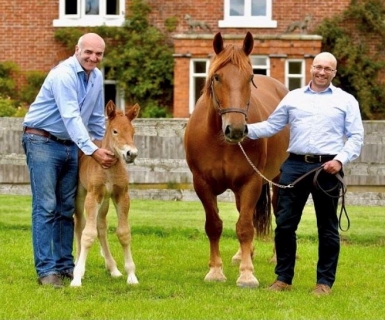
Tullis Matson (left), owner and managing director of Stallion AI Services, and Dr Gareth Starbuck, head of animal and equine sciences at Nottingham Trent University.
Dr Gareth Starbuck from Nottingham Trent University took the baton on Wednesday and gave a masterclass on the underlying principles of genetic diversity and how it needs to be maintained if a population is to remain healthy. He described the technique using sex-sorted sperm that made headline news in 2020 when a female foal was born to a rare breed Suffolk Punch mare called Ruby, providing hope for broader conservation efforts in the future.
Come Thursday, a marine biologist at the University of Derby, Dr Michael Sweet, kept the audience hooked with his focus on the biology of coral and the hope that inbuilt resilience together with scaled intervention measures may herald a bright future in spite of the many concerns linked with climate change.
As the week ended, Professor Ian Turner, also from Derby, delivered a very informative and engaging look at ‘Using Biology to Fight Crime’. Who would have imagined the intricate detail that our individual finger prints can reveal or how the beauty and specificity of pollen grains can lead to solving the most gruesome of crimes?
The talks from this week of events can be watched in full on the RSB YouTube channel.
Rosemary Hall MRSB
Colin Leakey Memorial Lecture: The myth behind the alpha male and other reflections of a career with animals
10 November 2020
With the formalities of the AGM completed and a bevy of enthusiastic helpers co-opted onto the committee, Professor Joanna Price, Vice-Chancellor of the Royal Agricultural University since 2016, began her eagerly anticipated lecture entitled: ‘The myth behind the alpha male and other reflections of a career with animals’.

Jo was brought up on a smallholding in Wales and dreamed of becoming a professional horse rider. However, her mother intervened and suggested she should become a vet! A degree at Bristol followed and she entered equine practice under Peter Scott Dunn, vet to her Majesty the Queen. Finding a suitable mentor is always a good idea, Jo highlighted. Exercise-related musculoskeletal injuries in horses posed serious problems, and dealing with them fired a genuine interest in the complexities of bone development and repair. Some years later, Jo would be studying for her PhD on bone formation in a human osteoporosis lab.
Using deer antlers as an in vivo model, Jo’s research involved investigating the interplay between the various cells, hormones and growth factors that affect the rapid growth of these extraordinary bones. No other mammal can naturally regenerate a lost organ, and the loss of antlers each spring is triggered by a fall in circulating testosterone levels. If a deer is castrated the antlers keep growing. However, at a cellular level oestrogen receptors are the main target as Testosterone is converted to oestrogen. Blocking ERs extends the length of the growth cycle i.e., has a similar effect as castration.
As a post-doctoral researcher Jo returned to the question of how exercise influences bone’s structure and function, and because osteocytes had been identified as the main mechano-sensors, gene expression was investigated in cultured cells and in vivo in mice. ERs were found to play a key role in bones’ adaptive response to loading. Lower levels affected the complex cellular responses to mechanical strain, and knocking out ERs in transgenic mice reduced bone formation on loading. Likewise in men, the ER has a profound effect on bone growth and metabolism. Clearly oestrogen and oestrogen receptors play a pivotal role in regulating the way bones grow, regenerate and adapt in both sexes and in different species.
As for antlers, they remain unique and important models for investigations into repair and regeneration, but many questions remain unanswered; e.g. where do the stem cells in the antler blastema (the structure on the frontal bone from which antlers regenerate) originate from and what controls them? A thought provoking question for others to solve and for us to ponder on.
Jo managed to combine a thrilling escape into the world of her research, with her perspectives as a highly successful woman in leadership, academia, and as a vet, all intertwined with humour and anecdotes. On behalf of the Committee, the East Midlands branch thank Jo for her time and our members for their attendance.
Rosemary Hall MRSB
Regional Schools Biology Poster & Essay Competition
27th and 29th June 2020
The East Midlands branch moved their Regional Schools Poster and Essay Competition to a virtual environment on the 27th and 29th of June after having to cancel the planned day of activities in March due to the COVID-19 pandemic.
Using the theme for British Science Week 2020, ‘Our Diverse Planet’, pupils in years 8-10 were charged with producing a poster whereas the older students in years 11-13 were asked to write an essay.
Ten schools registered entries and by the time the difficult decision had been made to postpone the event, the essays were in the hands of the judges. As the weeks passed by, it became abundantly clear that the event as planned would not happen, but the branch was adamant that the competition itself should be completed in some way so that the students could be rewarded for their hard work.
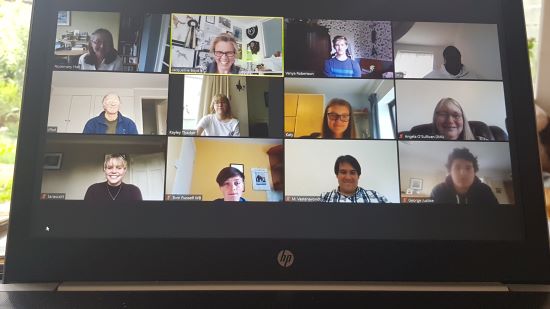
Accordingly, the team of four judges for the Junior Section requested photographic images of the poster entries. All posters were judged on their attention to detail, scientific content, originality and layout. The seven shortlisted entrants were invited online where their responses to questioning by a team of judges was also taken into account when deciding how to award the prizes.
The winner was Hazel Singleton from Leicester High School for Girls with her poster entitled 'Diversity 2111704' and the runner-up was William King from Loughborough Grammar School with his poster 'The Diversity in Feeding Behaviours of Urban Bird Life'.
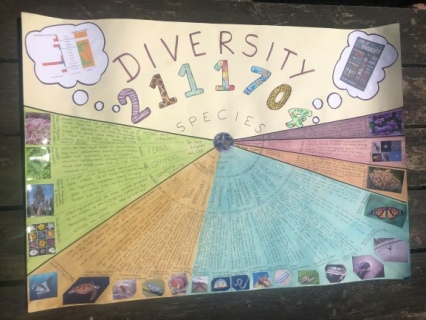
Similarly, in the Senior Section, seven students, representing five schools from across the East Midlands, made it to the online final. Vanya Robertson from Oundle School won with his essay on 'Diversification Mechanisms', whilst Kayley Thacker from Beauchamp College came in second with her essay entitled, 'The Cyborg next door'. The remaining five shortlisted entries from both sections received a highly commended award.
Winners this year received a £50 cash prize and the runners-up each received £30, kindly sponsored by Uppingham School. Hodder Education, publishers of the Biological Sciences Review magazine donated equivalent sums in book tokens which were sent to the schools to add Biology books to their libraries.
Marc Vastenavondt MRSB
AGM and The Colin Leakey Memorial Lecture
13 November 2019
Thanks were due to the University of Nottingham for hosting the East Midlands Branch AGM and Colin Leakey Memorial Lecture. The committee were delighted to introduce Associate Professor Dr Kim Hardie FRSB, and very grateful to her for agreeing to revisit and update the lecture that she had given earlier in the year in London: "The race between biofilm communities and us, in the fight against microbial resistance"
The means by which antimicrobials work, and how in turn the bacteria become resistant, were reviewed. What has caused increasing alarm is the speed by which resistance can spread, exacerbated by the misuse of antibiotics. Even Fleming, we were reminded, warned us about this in his Nobel lecture back in 1945.
“The time may come when penicillin can be bought by anyone in the shops. Then there is the danger that the ignorant man may easily underdose himself and by exposing his microbes to non-lethal quantities of the drug make them resistant”
Rather than under dosage, the current focus is to tackle antibiotic overuse. Great care must be taken in the way antibiotics are used in agriculture as well as in human medicine and global initiatives are vital for all of our survival.
The growing problem of infections proving to be resistant to most if not all types of antibiotic has led to a new document being published in January of this year: “Tackling anti-microbial resistance 2019-2024: the UK’s 5-year action plan”. Novel strategies to encourage companies to produce new drugs include the suggestion of de-linking the payment they receive from the volume sold to avoid the likelihood that a novel antimicrobial will be safeguarded as a last resort treatment.
Research is encouraged into alternative therapies such as the development of new vaccines and the use of bacteriophages. Who would have thought that the use of Triclosan, the active ingredient in many consumer products including toothpaste and cosmetics, alters the tolerance of bacteria to antibiotics?
Nottingham is a key partner in the National Biofilms Innovation Centre. It is hoped that new technologies such as the use of orbiSIMS (a 3D imaging technique), and optical nanosensors which can detect pH changes across a biofilm, will help to explain aspects of biofilm structure and formation alongside monitoring how antibiotics penetrate through biofilms.
This was a fascinating lecture with some amazing images left us all with hope for a bright future in this field of research.
Rosemary Hall MRSB and Kim Hardie FRSB
Postgraduate Public Engagement Poster Symposium
2 May 2019
Once again, the East Midlands branch hosted a Postgraduate Poster Symposium at De Montfort University (DMU) in Leicester. Co-sponsored by the Royal Society of Biology, The Linnean Society and the Universities of Nottingham, Leicester, DMU and Nottingham Trent, the event attracted scores of PhD researchers from across the region and beyond.
Professor Rusi Jaspal, pro vice-chancellor for research at DMU, opened proceedings by welcoming the Keynote Speaker, Dr Stuart Cantrill, chief editor of Nature Chemistry. Dr Cantrill delivered a fascinating talk entitled “From Knots to Nature” on research, publishing processes and pitfalls, and gin, making for an excellent opening to the symposium.
The quizzing of entrants and judging of their posters took place over the lunch break. Delegates had been tasked to present their research in a public engagement context, so it could be understood by a lay audience.
The posters were scrutinised by a team of experienced judges, including members of the RSB East Midlands branch committee, as well as Dr Cantrill, and Dr Sara Goodacre, our 2018 Colin Leakey Memorial lecturer from the University of Nottingham.
The judges chose Beth Rogoyski from the University of Leicester for First Prize with her eye-catching poster on “Redeployment: Identifying new purposes for old drugs in the war against cancer”. Beth received a £100 award from The Linnean Society, RSB merchandise, a host of Nature goodies kindly provided by Dr Cantrill, as well as a bottle of his own home-made gin.
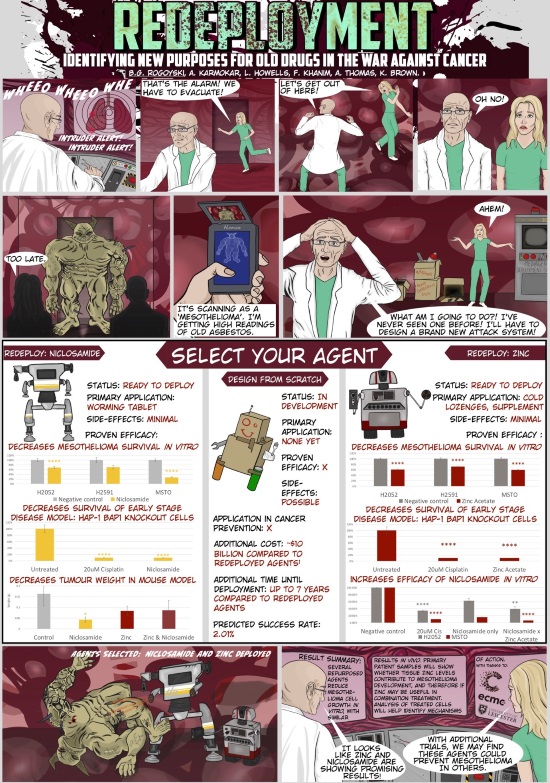 The First Prize poster by Beth Rogoyski
The First Prize poster by Beth Rogoyski
Second Prize, a £50 cheque from The Linnean Society plus similar ‘extras’ was awarded to JolantaBeinarovica from the University of Nottingham for her poster entitled “Self-assembling antimicrobial biomaterials based on spider silk”.
Runners up included Benita Percival from DMU with her poster outlining research linked with Nieman Pick Disease (Type C1) and Belal Hanafy, from Nottingham Trent University, with his work on a potentially promising non-surgical treatment for cataracts.

The prize winners and organiser from left to right: Keynote speaker, Dr Stuart Cantrill, Beth Rogoyski, Dr Philippe Wilson, Benita Percival, Jolanta Beinarovica, and Belal Hanafy.
Many thanks go to all of the sponsors and supporters of this year’s symposium. This much enjoyed event showcases the diverse and fascinating range of postgraduate research that is taking place and plans are already afoot for next year – may it grow even further.
Dr Philippe Wilson MRSB
Regional Schools Biology Competition
2 March 2019
The approach of British Science Week each year heralds the much-anticipated East Midlands Regional Schools Competition and, once again, thanks were due to the University of Leicester for hosting the event and welcoming some 140 people to the impressive George Davies Centre.
Pupils from years 8-10 were asked to produce a poster whilst the senior students (11-13) were charged with writing an essay on the chosen theme. In line with the University of Leicester’s Health Matters campaign, “Healthy Ageing” was the focus for 2019. The wide brief gave everyone the opportunity to concentrate on any biological aspect which interested them. In some cases, it was gratifying to see that personal experience had influenced their choice.
When not being quizzed by the team of professional judges, the students could visit and engage with a variety of interactive activities such as “Heartwize”, which enticed pupils to try some CPR or “Leicester Ageing together”, which showed how the city works to support the elderly.
The judging teams were kept busy well into lunch and beyond and whilst their debates continued, the parents, teachers and students enjoyed a short lecture by Professor Elizabeta Mukaetova-Ladinska. From defining old age to strategies for “Ripening to Perfection” the professor emphasised the many interrelated factors which have a bearing on healthy ageing.
As the event drew to a close, all of the entrants were commended for their hard work, but the winners included Olivia Bryant from Uppingham School who was awarded first prize for her poster on ‘House Plants’ and the positive effect they can have on the people that tend them.
In the senior section, David Noyvert from Beauchamp College received first prize for his essay ‘Healthy Ageing – could mitochondria be key?’. The judges were impressed with the detailed knowledge that was demonstrated in all of the essays and posters as well as in their discussions with the entrants in each section. Well done to everyone involved!
Rosemary Hall MRSB
AGM and The Colin Leakey Memorial Lecture
14 November 2018
Once again thanks were due to the University of Nottingham for hosting the East Midlands branch AGM and lecture. Dr Cas Kramer, the outgoing chairman, began proceedings by reading a short tribute to Professor Colin Leakey who died in January of this year. A Fellow of the Royal Society and a former chairman of the branch (2009-11), Colin achieved much in his lifetime and his knowledge and expertise was recognised throughout the scientific community. As such, the committee wished to dedicate this, and all future AGM lectures, to his memory.
Associate professor Sara Goodacre had posed the question ‘What Makes a Spider Fly?’ Many in the audience had likely never witnessed this ballooning behaviour, so Dr Goodacre demonstrated how they might climb to the top of a structure such as a gate post, tip their abdomen into the air and release about a metre of silk. This is picked up by the wind and the spider takes off, reaching heights of possibly thousands of metres into the air.
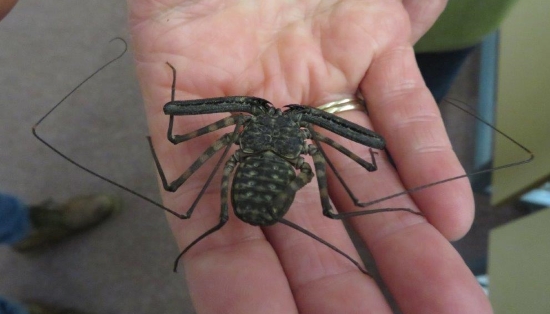
Close encounters with an African Whip Spider
Studies with Linyphiid spiders such as the money spider, Erigone atra, have shown this to be an active choice and 40-60% of the population tend to balloon. No wonder that wind-blown spiders are often the first species to colonise areas like newly formed volcanic islands.
Having become used to the idea of spiders at altitude the audience were then shown a short video clip of a sailing money-spider. They can raise their legs and use them as sails if they land on water. In human terms, it is important to understand more about the behaviour and distribution of spiders in natural populations. In agro-ecosystems they are natural predators, and there is much potential to make more use of their ability to eat common insect pests such as aphids.
Amazing biodiversity and fascinating ways of moving about in hazardous environments: it is no wonder that Dr Goodacre challenges the public perceptions about spiders and gets children to love them. There was even an arachnid amongst her entourage; an African whip spider who caused much interest as the event came to an end.
Rosemary Hall MRSB
Schools Biology Poster & Essay Competition
10 March 2018
In celebration of British Science Week 2018, the East Midlands Branch was delighted to meet some 46 students from local schools who had opted to enter the Biology Poster/Essay Competition, our flagship event.
Using the theme "Mental Health Matters", pupils in Years 8-10 were charged with producing a poster or model whilst the older students (11-13) were asked to write an essay on any aspect of mental health that interested them.
The day was hosted by the University of Leicester's Health Matters Team and the brand new venue – the George Davies Centre, caused quite a stir amongst the students, their teachers and parents. This very spacious and welcoming space is the largest Passivhaus (extremely low energy) building in the UK. Refreshments over, a short interactive session with mini-talks and hands-on activities encouraged lots of chatter and thought provoking questions.
The judging began with a team of academics assigned to each section. A few nervous glances were exchanged as the professionals moved amongst the students who were getting ready to 'defend' what they had worked so hard to produce. All agreed that the challenging theme brought a fascinating variety of responses and some excellent work.
After lunch, while waiting for the deliberation of the judges, Dr John McDonald gave a short lecture with the intriguing title "Why love matters – how affection shapes mental health and how to reshape it".
Finally, congratulations were due and thanks were given to the Edith Murphy Foundation, which sponsored the prizes. The Junior winner was Hannah Iza Kim for her poster on "Sleep & Mental health"; Sam Gascoigne was runner up for his poster entitled "Guess Who" and Callum Connolly's poster "Seeing beyond the third dimension" was highly commended.
The seniors 1st prize went Jess Harding for her essay "How strongly linked are mental & physical health?" The runner-up was Heather Jones with her essay "Electroconvulsive Therapy: inhumane or a viable treatment option?" and Hannah Williams' essay "The science behind comfort eating" was highly commended.
Mrs Rosemary Hall MRSB
AGM and Lecture
21 November 2017

Thank you to the University of Nottingham for hosting a fantastic AGM for the East Midlands branch in November. After the formalities of committee business were completed, the audience heard from the recent winner of the Postgraduate ‘Poster Walks’ Competition, held in Lincoln earlier in 2017. Robeena Farzand demonstrated with ease the communication skills that won her first prize as she explained her research project, which looked at the special DNA elements (ICE) in Klebsiella pneumonia which impact on fitness, virulence and antibiotic resistance. Robeena emphasised the need for more antimicrobial resistance research looking at preventing DNA transfer between different species of bacteria.
Finally, the audience were treated to a fascinating lecture from Professor Kevin Morgan. With great enthusiasm he shared with us some of the latest advances in Alzheimer’s genetics research. Studies since 2009 have lead to a massive increase in our understanding of the complex interactions that lead to the neuroinflammation central to this debilitating disease. Currently there is no cure, but it is clear that more effort is needed to analyse the genetics of patients before drug trial, and there is much promise in developing polygenic risk scores (PRS), based on various low-risk variants spread throughout a patient’s genome.
Continued research, collaboration and data sharing is paramount and should help to identify increase the likelihood of disease-specific treatments and individualised medicine.
Towards the end of his talk, Kevin said: ‘When surrounded by good people, good science becomes easy. We all put progress in our field for our patients before personal gain’ – a fantastic way to end the evening and an inspiring sentiment to pass on to the next generation of researchers.
Dr Marie Nugent, University of Leicester
Fungus Foray, Twyford Wood
22 October 2017
October saw the annual gathering of members and of the local Wildlife Watch / RSPB Explorers at Twyford Wood, near Colsterworth in south Lincolnshire. About 20 people were lead by Jane Ostler and the author (DRF) – with his faithful and battered copy of ‘Mushrooms and other fungi of Great Britain and Europe’ (Phillips, 1981).
Twyford Wood has a good range of different habitats, with both pine and deciduous woodland, some wet grassland and some open areas where there used to be an RAF airfield during the war. The magic was enhanced by glimpses of roe deer and the fact this site was the home of the 1989 Dr Who serial Battlefield.
Over the last few years, our group has listed 102 species of fungus in Twyford Wood, 92 of those coming in one year alone. In spite of the wonderful efforts of the children in the group, only 26 species were found this October – the lowest in 30 years – together with a few lichens. Even the species we did find were in low numbers. For instance, the usual vast spreads of the sulphur tuft, Hypholoma fasciculare, were missing and we appeared to be lucky to find any at all.
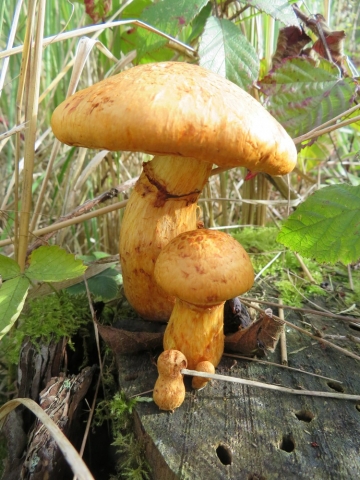
Thanks to local expert Jane Ostler for her vast knowledge of Twyford Wood; to Marianne Overton, for organising the event; and to Jean Martin for her recording skills. Thanks also to the Forestry Commission for permissions granted.
The event was organised as part of a series of family events aimed at getting children engaged in learning about our local wildlife. The West Kesteven Wildlife Watch and RSPB Explorers Group is a local group which forms the junior part of the Wildlife Trusts and RSPB. Anyone interested in the series of monthly family events should contact Marianne Overton MBE MBE or Jean Martin
David Feld FLS CBiol MRSB and Marianne Overton MBE
Postgraduate Poster competition
2 May 2017
Biological science students from across the East Midlands region came to the University of Lincoln in May to compete in the inaugural postgraduate poster competition held as part of the Lincoln Festival of Biology.
The aim was to find the student who could best explain their Masters or PhD project to a public audience. Each student was given just four minutes to explain their work and display their posters to two teams of independent judges from industry and academia during ‘poster walks’.
University students and invited public then spent the afternoon quizzing the postgraduates about their work and many showed surprise at how diverse the subject of ‘biology’ could be.

The judging teams (Chaired by Dr Geoff Buck) had a very challenging task to decide which was best from the thirty excellent posters and talks, but awarded the cash first prize to Robeena Farzand from the University of Leicester (Fitness, bugs and DNA); second prize to Mike Shaw from the University of Lincoln (Viruses to treat acne) and highly commended to Ben Chivers from the University of Lincoln (Sound generating organs in crickets and their allies).
One postgraduate student said ‘I really enjoyed the event - the East Midlands branch had provided travel grants and lunch to participants, we were able to explain our work, collect CPD points and were given excellent opportunities to network with other students across the region’.
Dr Ron Dixon FRSB
Leicester High School for Girls Poster Competition
14 March 2017
Disappointed that the annual Regional Schools Competition was not going ahead this year, Leicester High School for Girls approached the East Midlands Branch for help with their Year 9 Biology Poster Competition, due to be held as part of their celebrations for British Science Week 2017.
Accordingly, three academics were enlisted as judges and it was decided we would sponsor the first prize of £50 while the school provided prizes for the runners-up.
The students were given the theme of "Great biological discoveries that changed the world" and worked alone or in pairs and were quizzed by the judges on day. It was very gratifying to see just how much research had gone into producing their final posters.
In all respects it was relatively easy to pick out the overall winner as her work and knowledge on Landsteiner and the discovery of blood groups was so impressive. Three runners up had produced work on antibiotics, open heart surgery, and radiotherapy & X-rays. Well done girls!
Mrs Rosemary Hall MRSB
Making a 1000-year old antibacterial
10 November 2016
Some of the 60 or so attendees for the East Midlands AGM may remember little of those brief proceedings, but instead, may have left the Keighton Auditorium, University of Nottingham, determined to brush up on their Anglo-Saxon.
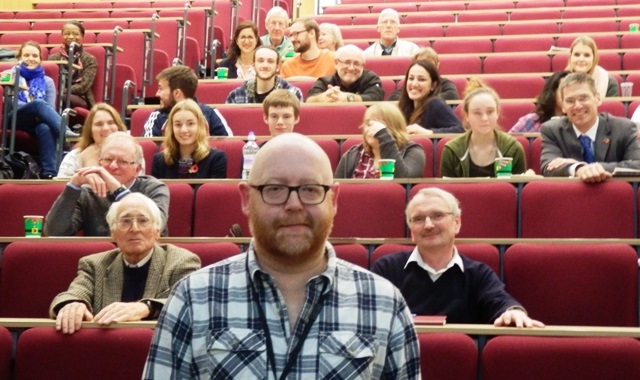
Dr Steve Diggle described how he and colleagues from both the sciences and humanities had followed an ancient recipe in Bald’s Leechbook, an old medical text compiled in the ninth century, with astounding results.
“Work an eye salve for a wen, take cropleek and garlic, of both equal quantities, pound them well together, take wine and bullocks’ gall, of both equal quantities, mix with the leek, put this then into a brazen vessel, let it stand nine days in the brass vessel, wring out through a cloth and clear it well, put it into a horn, and about night time apply it with a feather to the eye.”
Taken from Cockayne’s 1865 translation, the “wen” was probably a sty, an infection of an eyelash follicle usually attributed to the bacterium Staphylococcus aureus.
Great care was taken to follow the recipe as stated although “cropleek” demanded another, somewhat ambiguous, Allium species. Accordingly, batches were made up with either onion or leek and squares of brass sheet were used to simulate the brass/bronze vessel. Following an ancient recipe to this degree is most rare, so the discovery that the resultant clear, slightly acidic brownish liquid really did work wonders amazed the laboratory and sent the national press into somewhat of a frenzy. Perhaps most notably, the remedy killed that most notorious of pathogens, methicillin-resistant S. aureus (MRSA) in a mouse chronic wound model.
Furthermore, laboratory results repeatedly confirmed that it is only the combination of all of the said ingredients that results in significant bactericidal activity, and even waiting the nine days was important.
Steve Diggle and his co-workers are left with many unanswered questions, but the hope remains that therein could be much potential in an otherwise doom-laden area of concern regarding increasing levels of antibiotic resistance.
Mrs Rosemary Hall MRSB
The Art & Science of Brewing
14 July 2016
Professor Charlie Bamforth is a distinguished professor in the Department of Food Science & Technology at the University of California, Davis. English by birth, Charlie is a Fellow of the Society and an honorary professor on the Sutton Bonington campus of the University of Nottingham. In both 2014, and this year, he has come to Nottingham throughout July to teach a summer abroad class.
Hence, some 30 plus members and their guests were lucky enough to hear Charlie’s talk about brewing, a fascinating science which encompasses complex aspects of biochemistry and enzymology.

The end product, treated with respect, has health giving properties too. Historically, social history records even remind us that it was those drinking porter who survived the scourges of cholera that plagued early urban lives. In some circles Charlie is known as the “pope of foam” because some of the research in his laboratories focuses on creating the perfect foam and with it, the best of tastes. We even had a mini lesson on how to wash glasses efficiently so as not to disrupt the all-important head of foam.
When the talk concluded, we all raised our glasses to toast the now ‘Royal’ Society of Biology.
Tours of the brewery followed, led by Bruce Wilkinson, who together with Geoff Mumford had purchased the Burton Bridge Inn back in 1981 with a view to setting up their own small brewery. He spoke of the the importance of the water, with its perfect balance of Burton salts, the various cereal grains (some with an intriguing, chocolately taste), and the hops, which we rubbed together in the palms of our hands in order to savour their aroma.
What a lot to consider, not forgetting the yeasts of course. And what fun to climb a step ladder and peer into the bubbling tanks before us!

Such a lot going on in a relatively small space and a truly memorable evening.
Mrs Rosemary Hall MRSB
Charter Lecture by Sir Walter Bodmin
26 April 2016
Sir Walter enthrals with a talk entitled “Genes, history and archaeology: A case study of the British People”.
Sir 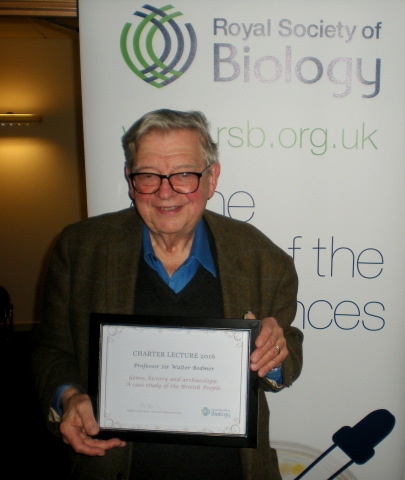 Walter Bodmer’s talk gave some fascinating insights into the fine-scale structure of the British population. Generally, the population structure within the UK is limited, with only three genetically distinct regions evident when using less refined methods.
Walter Bodmer’s talk gave some fascinating insights into the fine-scale structure of the British population. Generally, the population structure within the UK is limited, with only three genetically distinct regions evident when using less refined methods.
The Orkneys are obviously quite different, undoubtedly a result of long term Viking influence (875-1472). Wales is also relatively distinct from the rest of the UK.
However, the fine detail described in this study demonstrates an equivalence between clusters and what may have been ancient kingdoms and geographical boundaries. Thus Cornwall and Devon show distinct differences between themselves and the rest of England and another subtype roughly follows the Wales/England border.
The well recognised ‘little England in Pembrokeshire’ also shows prominently. At a finer level there are some differences between North and South Wales become evident but there is no evidence for a general ‘Celtic’ population.
Central and Southern England were found to be the most homogenous regions with the largest influence from Anglo-Saxon migration, although this is estimated to be less than previously thought at between 10 and 40 per cent.
Nevertheless, perhaps the most significant finding is that the populations have been relatively stable over a long period of time in spite of various invasions and occupation.
As Sir Walter drew his intriguing and thought provoking lecture to a close, the audience responded with many questions revealing their keen interest in his research. Were they still pondering their own genetic lineage as they made their way home?
Dr J F Hall CBiol MRSB
Regional Schools Biology Competition
12 March 2016
Valued sponsorship from the Society for Endocrinology (SfE) enabled local youngsters, accompanied by their teachers and parents, to gather at the University of Leicester to celebrate the start of British Science Week. Professor Saffron Whitehead represented the SfE and contributed much to the day's activities. A hands-on activity session gave students the opportunity to ask her about the roles of the various endocrine glands, while a rolling power point provided extra visual and factual detail that would prove invaluable in the quiz she had devised.
The senior students heard from Mr Gareth Price, a PhD student from the University of Lincoln, who explained some aspects of his research into how diabetes affects the kidneys. Meanwhile, Ms Rebecca Pritchard from the Diabetes Research Centre at Leicester had her hands full with students pedalling away on exercise bikes (endorphins alert!) and contemplating lifestyle choices.
In the same laboratory a bench full of very large books surrounded Dr Marie Nugent, a recent postgraduate from the University of Leicester. Inside, in very small font and to everyone's amazement, she revealed the complete base sequence for the whole of the human genome. "That has made my day," said one of the teachers present.
The business of the day followed, with the junior competitors standing by their posters and models, and the seniors by their essays. All had to defend their interpretation of the theme for the day - 'Endocrinology: biological messaging'.

If not being quizzed by the judges, the students were racking their brains to complete the aforementioned quiz. A relaxing lunch followed and then everyone listened with much interest to a short lecture by Professor Whitehead, entitled, 'Hormones, homeostasis and health'.
Finally, the difficult judging over, £50 first prizes were awarded to Roshan Klein-Seethararman (Lutterworth High School) for his poster on insulin and to Olivia Greatbatch (Denstone College) for her essay highlighting some of the ongoing and exciting research in the field of microbial endocrinology.
Rosemary Hall MRSB
AGM & Defeating Cancer Lecture
12 November 2015
Over 90 attendees made their way to the Great Hall at the University of Nottingham for the lecture 'Defeating Cancer - why it is such a challenge?' As it stands, 1 in 3 of us will suffer from the disease and 1 in 4 of us will die from it – a sobering statistic presented very early on by Professor Andrew Fry from the University of Leicester.
This disease, of which there are over 200 different types, can best be thought of as a distorted version of our normal selves. The cancerous changes are due to the accumulation of mutations with time that lead to the hyperplasia (overgrowth of cells) and dysplasia (altered cell behaviour) associated with the disease. Tumour heterogeneity studies have also revealed the amazing plasticity of cancer. As metastasis progresses a cancer can undergo an evolutionary process within the body, creating many genetically distinct cells.
The name originated in 400 BC when Hippocrates gave an incurable condition the name Cancer (karkinos in Greek) - alluding to the crab like appearance of a tumour surrounded by the blood vessels 'feeding it'. Who would have thought that chemotherapy's beginnings arose from noticing the reduction in the white blood cell count in survivors of mustard gas attacks in the First World War.
Nitrogen mustard was given intravenously – a terrifying thought back then, but cytotoxic Mustargen is still used today to kill rapidly dividing cells in leukaemia and lung cancer. The side effects of such agents are all too familiar and not surprising because many of our normal cells are actively dividing too. For every minute that we sat in the audience we were making 12,000 million new gut cells, 300 million new red blood cells and new hair deep in the follicles of our skin.
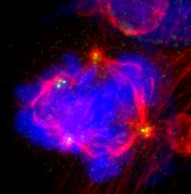 The natural chemotherapeutic agents, Taxol (derived from Yew) and the vinca alkaloids (Madagascar Periwinkle), work in a different way because they affect microtubules – intracellular structures of particular interest to Professor Fry. These drugs prevent the pulling apart of the chromosome copies on the mitotic spindle, thereby preventing cell division. Short video clips, some using the latest fluorescent imaging techniques, highlighted the mitotic process and the effect of drugs that prevent cancer cells dividing.
The natural chemotherapeutic agents, Taxol (derived from Yew) and the vinca alkaloids (Madagascar Periwinkle), work in a different way because they affect microtubules – intracellular structures of particular interest to Professor Fry. These drugs prevent the pulling apart of the chromosome copies on the mitotic spindle, thereby preventing cell division. Short video clips, some using the latest fluorescent imaging techniques, highlighted the mitotic process and the effect of drugs that prevent cancer cells dividing.
Molecular biology has allowed great understanding of how mutations affect the start/stop signals in cancerous growth. In chronic myelogenous leukaemia, for example, this has enabled development of drugs that block the fusion protein produced as a result of the reciprocal translocation between chromosomes 9 and 22. Advances in structural biology have also enabled more successful design of drugs that can inhibit the proteins driving the cancer. Furthermore, rapid sequencing of a person's genome will allow treatment to be targeted to the mutational profile of each individual patient. However, most patients on targeted therapies relapse through drug resistance, presenting another challenge!
What of the future? The ambition now is to achieve a 75% survival rate following a cancer diagnosis, as compared to the current 50%. Early diagnosis is paramount – perhaps blood tests that can reveal the oncogenes that are shed into the blood, 'breathalysers' that copy dogs and can detect the cancerous molecules in a person's breath? Many cancer cells have too many centrosomes, but nevertheless are able to cluster them into the poles of the spindle and divide. If drugs could prevent this clustering the cells would die. Hope indeed, but a challenge it remains.
Professor Fry is very grateful to Worldwide Cancer Research, Cancer Research UK and Hope Against Cancer who fund the research in his laboratory.
Rosemary Hall MRSB
Hammond Arboretum
16 June 2015
Members of the East Midlands branch enjoyed an evening meeting at the Hammond Arboretum of the Robert Smyth Academy, Market Harborough, on one of the few warm and sunny evenings of the summer thus far. The talks and guidance were by the school's retired head of biology, George Marshall MRSB, who doubles as curator, historian, propagandist and fundraiser. George is supported admirably by Gilli Claycomb, whose maps, excellent tree labels and extensive botanical and plant lore knowledge are central to the appreciation of this extraordinary gem of bio-conservation.
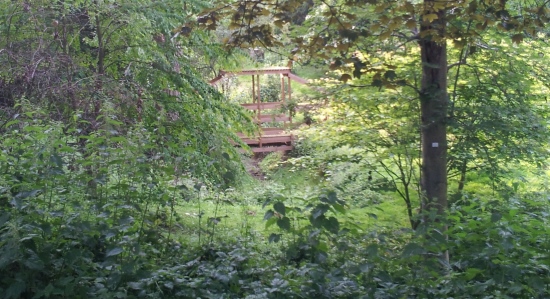
In around 1911 Francis Hammond, then headmaster of the local Grammar School, decided to plant an arboretum in a plot he had bought at the end of his own garden. In 1913 he was able to obtain fine young trees from commercial nurseries with a strong emphasis on non-native species of suggested medicinal values.
When he died in 1937 there were as many as 2,000 trees and shrubs in the collection, which must have been one of the finest small arboreta in the country.
This arboretum can be considered a living laboratory of economic botany and phytotaxonomy. Here visitors can benefit from seeing, touching and learning about a select collection of mainly unusual trees, some of which are distinctly rare in cultivation. Much more important may be that many can furnish sources for pharmacognosy, which is staging something of a resurgence of interest as more and more ailments and their pathogens become resistant to the chemists' and now biotechnologists' ever more costly attempts to overcome them.
The labelling of the trees and shrubs is informative to the Linnean binomial level and the geographically native origins of each are given. The non-use of family names may somewhat mask the relevance of plant family affiliations with physiologically active biochemical metabolites. Those associations are just what the modern researchers, and those of the last fifty years or so have followed in their searches for new useful molecular structures of actual or potential value.
The excellent well illustrated guide to the arboretum, with Gilli Claypole's map in centrefold, is well worth detailed study. Walking in pleasant gardens with a notebook is, I think, a good habit for lifelong botanical self-education. This reviewer's notebook overflowed.
Colin Leakey FRSB
Lunch on the edge: Welbourn
6 June 2015
In the latest of a series of clifftop 'lunches on the edge', about 30 naturalists from the East Midlands branch of the Society and the British Trust for Ornithology (BTO) converged on Hilltop Farm at Welbourn in Lincolnshire, at the invitation of Marianne and Peter Overton.
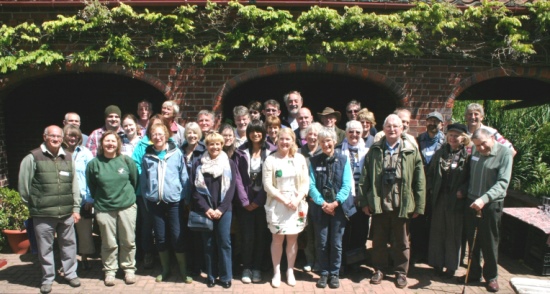
The farm is situated on the outskirts of the village, a few miles south of Lincoln and high up on the Lincoln Escarpment, where it overlooks the broad expanse of the Trent valley to the west.
The programme for the day was in three parts: a bird-ringing session, a formal talk and – most important – lunch! There was also the opportunity for some of us to carry out specific wildlife surveys – in my case, snails.
Donna Staples and Ian McGregor of the BTO's Mid-Lincs Ringing Group led the group round a conserved, circular area of woodland-bordered pasture in which they had rigged up several mist-nets. Donna showed the group how she and Ian captured birds, checked their species, age, sex (by blowing feathers away from the cloaca) and ringed status – and, if un-ringed, ringed them while we watched.
Twelve birds of ten species were caught, including a juvenile pied wagtail (Motacilla alba) and six re-traps. Also of interest were several nesting great tits (Parus major).
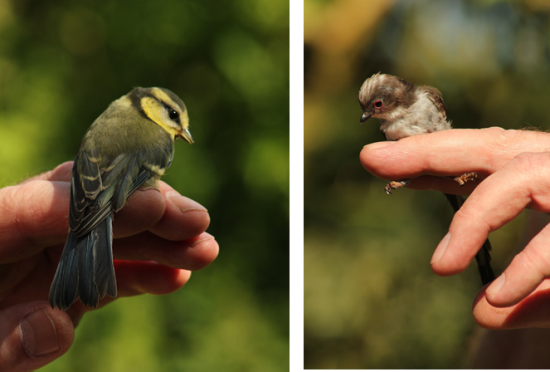
Back in the Overtons' garden, local celebrity-biologist and 'slug-man', Chris du Feu gave a very witty and thought-provoking talk entitled 'Little People in the Wildlife Classroom', about the need to get younger generations interested and involved in the natural world. His audience made him work for his supper with a lively question-and-answer session.
The Overtons had laid on a superb cold buffet – which gave the assembled naturalists the opportunity to meet and mingle. Everyone present agreed that the latest 'lunch on the edge' had been a great success – although a few more birds would not have gone amiss.
It is hoped that, later in the year or perhaps next year, a Bioblitz [in which a weekend is given over to producing a complete species list of an area] will be organised at Hilltop Farm by the Lincolnshire Naturalists' Union. We've already made a start on the slugs and snails – and on the birds, of course.
David Feld MRSB
Regional Schools Competition
14 March 2015
With GENIE, the Centre for Excellence in Teaching and Learning in Genetics, as the annual host, some 100 or so visitors streamed into the University of Leicester. Competitors, family members, teachers and judges for the Schools event crossed paths with guided tours for prospective undergraduates giving an extra buzz to a normally quiet Saturday morning.
Students from years 8 to 13 were celebrating the start of the newly named British Science Week (formerly National Science & Engineering Week). In the junior section (8-10) pupils had prepared posters on the theme "Extreme biology" whilst the older students submitted essays. How different were their interpretations and hence what a challenge for the teams of judges!
Whilst parents and teachers exchanged supportive smiles with the apprehensive students, they in turn waited to be quizzed by the judges on their approach and content of their poster or essay. This, the most testing aspect of the competition, is what makes it so special.
Having relaxed over lunch, everyone was eagerly anticipating the lecture to follow when Dr Shaun Cowley from the Department of Biochemistry would talk on "Stem cells: from the origins of life to tissue regeneration". Meanwhile, in the judges room, quite heated discussion continued for some time, pens hovering over the certificates and cheques for £50 that would be awarded to the winners! Decisions made, the winners were congratulated.
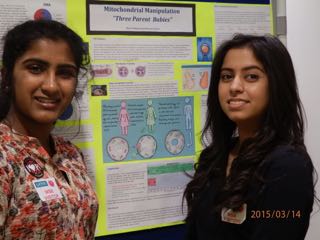 Junior prize winners
Junior prize winners
Rhea Suribatala and Shreeya Thakrar scooped the first prize in the junior section with their poster "Mitochondrial manipulation" whilst runner-up Adam Dodd received £20 for his exposition on Tardigrades, "When the going gets tough, the tough get going". A runners-up prize also went to Orieanna Reeve-Chen and Namrata Joshi for "The world's toughest bacterium".
In the senior section, Lauren Church won with her essay "Extreme biology: Moving to Mars". The two runners up were Freya Hartshorn with "Where do we draw the line" and Aditi Pandey with "The extremes of medical treatment: Nanotechnology and robotic surgery".
Rosemary Hall MSB
Tour of Moulton College and Postgrad Symposium
16 December 2014
With the excitement of the end of term over, a small group of us were treated to a special tour of some of the facilities at Moulton College. Especially instructive was meeting one of the associate lecturers, Jessica York, in the Equine Therapy Centre. Her current research aims to provide quantitative analysis of the way horses move when exercising through different depths of water. Reporting on some of her results later in the symposium, it was obvious how this will promote best practice when using the aqua-treadmill to rehabilitate and exercise horses.
Next stop was the Sports Therapy Centre with its state-of-the-art facilities including a 25m, six lane swimming pool with moveable floor and a whole body cryotherapy chamber. We walked through the latter trying to imagine what it would be like when set at -60 C to -140 C. Using extremely cold temperatures for short periods has been shown to naturally stimulate the body to decrease inflammation and pain and promote healing as a result.
Moving on, we caught a glimpse of canine hydrotherapy and some posh grooming before touring the Animal Welfare Centre. We saw Meerkats on the lookout in the winter sun, porcupines, tropical birds, rabbits and guinea pigs, tree frogs, an array of different reptiles and even a civet.
Some of the many different areas of research at the college were highlighted in the afternoon symposium. From "Why did the harvest mouse cross the road?" to the research into Specific Replant Disease that affects several economically important fruit and ornamental trees, the list of topics was noticeably diverse and drew many interesting questions from the assembled audience. Many thanks, Moulton, for a fascinating day.
Rosemary Hall MSB
AGM and lecture - a world without antibiotics
11 November 2014
Professor Richard James, of the University of Nottingham, gave his perspective on the somewhat alarming scenario that the world may be approaching a time when antibiotics have little value as therapeutic agents. Over-use, misuse and insufficient incentives to develop new products all contribute.
In his early career, James was fascinated by the many different mechanisms through which antibiotics exert their effects, and soon realised that bacterial resistance to antibiotics would be an increasingly serious problem. He championed the call for additional research until in 2007, he launched the Centre for Healthcare Associated Infections (CHAI) at Nottingham amidst charges of being a sensationalist and scaremonger.
Beta-lactamases are rapidly making the penicillin-based antibiotics redundant and resistance is growing even to the carbapenems, which are known as the antibiotics of last resort against some key gram-negative pathogens. As more antibiotics are used the selection pressure intensifies and as people move so does resistance. Transposons, together with the ease by which plasmids bearing resistance genes can be transferred between pathogens, mean that resistance develops far quicker than we can respond. Hopes were raised between 1995 and 2001 when targeted gene-based technologies were introduced. Costing billions, but with no new antibiotics on the market, the search continues via the old method of random screening.
Potential solutions include a tax on every use of antibiotics. However, this would have to be introduced in all antibiotic using countries and yet not disadvantage the poor. Rapid molecular diagnostic tests are vital, as is co-ordinated international action. More education, no prescribing before microbiology results are available and, of course, stopping the routine use of antibiotics in agriculture.
With record numbers in the audience, Professor James fielded many thought provoking questions, but made it clear that there are no easy answers.
Rosemary Hall MSB
O'er the Wall at Moulton College Estate
5 July 2014
A warm welcome awaited the small group of would be botanists eagerly anticipating a wildflower walk in the grounds of Moulton College. Brian Laney, a self-taught botanist with over 25 years' experience, led us through the afternoon's mini 'bioblitz', identifying the flora of different plant communities in the gardens and conservation area.
Brian is involved with the local conservation efforts for species such as Shepherd's Needle (Scandex pectin-veneris) and Subterranean Clover (Trifolium subterraneum), both of which were shown to the group during an introduction by Adrian Stockdale (senior lecturer in horticulture).
One lawn produced a good number of species due to the mowing regime, including Wall Speedwell (Veronica arvensis), Lesser Trefoil (Trifolium dubium) and Thyme-leaved Speedwell (Veronica serpyllifolia). While wandering along the edge of one particular field the group spotted Grey Field Speedwell (Veronica polita), a species much overlooked in the county, while Cuckooflower (Cardamine pratensis) was recorded in damper ground. Further along and bordering a stream there were a number of different species including Great Willowherb (Epilobium hirsutum), False Oat-Grass (Arrhenatherum elatius), Hop (Humulus lupulus), Water Mint (Mentha aquatica), Fool's Water-cress (Apium nodiflorum) and Butterbur (Petasites hybridus).
Whether close up with the hairy leaves of Common Mouse-ear (Cerastium holosteoides) or musing on the hidden meaning behind the name of the purple flowering Selfheal (Prunella vulgaris), the hours sped by and everyone agreed that they had learnt something from Brian.
Rosemary Hall MSB and Brian Laney
Lunch on the Edge
8 June 2014
Lunch on the Edge was hosted at the award-winning Hilltop Farm on the cliff edge overlooking the Trent Valley. The morning, led by Donna Staples, began with successful bird ringing - 31 catches of twelve species, including a marsh tit.
Paul Learoyd, chief executive of the Lincolnshire Wildlife Trust, delivered an excellent presentation on conservation in Lincolnshire. Over 60 years the Wildlife Trust in Lincolnshire has made astounding strides, purchasing reserves and saving species, but perhaps more importantly working with others to enhance wildlife habitat throughout the county.
With over 25,000 members locally, the Wildlife Trusts also work together to influence central government in their policies. Lincolnshire has taken a particular lead in seeking to establish coastal and marine parks, work which continues.
View a slide show of some of the animals seen. Photos courtesy of Clare Adams.
Marianne Overton CBiol MSB
Regional Schools Competition
22 March 2014
As National Science and Engineering Week drew to an end, the East Midlands branch enjoyed another successful schools competition held at the University of Leicester. It a lovely spring day and showcased the flair, hard work and dedication of some 28 students from regional schools and colleges. Whether in poster, essay or podcast format their task was to 'Explore the Future' - what would the future hold in biological terms?
Judges, teachers, parents and students, ensured a lively atmosphere and much discussion as students were quizzed on the content and background of their work. Much debate ensued, even after lunch, whilst Dr Salvador Macip from the Department of Biochemistry gave his short lecture entitled 'The Quest for Immortality'. Following the theme of exploring the future, Dr Macip seemed in no doubt that we would be able to extend our lifespan. Getting rid of old cells might be the answer, especially as new research had identified a drug that targets and destroys older cells, thus preventing their damaging effect on neighbouring cells. However, Dr Macip posed an interesting question – 'Do we want the power of immortality on our small and already full planet?'
Sarika Patel (below center) won first prize in the Junior Section with her poster on 'Vertical Farming' and Hannah Erlebach (below left) was runner up with 'Genetics: Engineering the Future'. Two others were highly commended – Zoe Callow (below right) with 'Stem Cells' and Jake Ellar with 'Whale Evolution'.
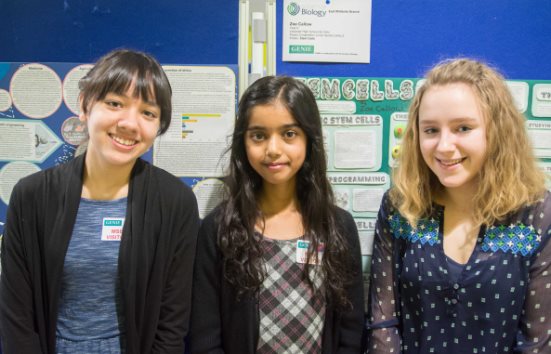
In the senior section first prize was awarded to Chen Liu for her excellent essay entitled '3D Organ Printing – Can I really Print My Own Liver?' The two runners up were Alisha Patel with 'Da Vinci The Surgeon' and Matthew Clayton with 'Underwater Living'. Emily Cooke was highly commended for her 'Terraform: The Future?'
The day drew to a close with the awarding of a very special prize to Hannah Musson, a Year 13 student who had entered this competition for 4 years running! The book tokens she received would come in useful, we hoped, when she embarks on her degree at the University of Leicester.
The future does indeed look bright!



